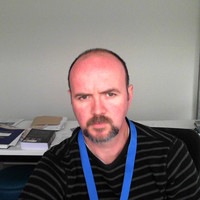Samuel Foucher
Computer Research Institute of Montreal, Vision and Imaging Team, Department Member
ABSTRACT
Research Interests:
Develop tomorrow's solutions using cutting-edge research from the Yellow Books the SPIE conference proceedings. During July, get 1/3 off Yellow Books currently in stock (Advance Orders are not included). Prices shown are sale... more
Develop tomorrow's solutions using cutting-edge research from the Yellow Books the SPIE conference proceedings. During July, get 1/3 off Yellow Books currently in stock (Advance Orders are not included). Prices shown are sale prices. ... Browse by conference, year, or ...
Research Interests:
Research Interests:
Research Interests:
Research Interests:
Research Interests:
Research Interests:
ABSTRACT
Research Interests:
Approach we have tested in each of your submitted runs. For the “Object Put ” event, we followed a dual foreground segmentation approach where the output difference between a short term and a long term model is used for triggering... more
Approach we have tested in each of your submitted runs. For the “Object Put ” event, we followed a dual foreground segmentation approach where the output difference between a short term and a long term model is used for triggering potential alerts. For Pointing, Embrace, CellToEar and PersonRuns, we applied the learning of compound spatio-temporal features based on a data mining method. Relative contribution of each component of our approach. Our system is based on an action recognition approach which is mining spatio-temporal corners in order to detect configurations, called Compound Features, typical of an action of interest. The final detection is based on blobs around local frame-to-frame changes that are containing enough relevant compound features. What we learned about runs/approaches and the research question(s) that motivated them. Overall, performances have improved from last year especially for PersonRuns. In addition, the training for PersonRuns was based on a standard a...
Although people or object tracking in uncontrolled environments has been acknowledged in the literature, the accurate localization of a subject with respect to a reference ground plane remains a major issue. This study describes an early... more
Although people or object tracking in uncontrolled environments has been acknowledged in the literature, the accurate localization of a subject with respect to a reference ground plane remains a major issue. This study describes an early prototype for the tracking and localization of pedestrians with a handheld camera. One application envisioned here is to analyze the trajectories of blind people going across long crosswalks when following different audio signals as a guide. This kind of study is generally conducted manually with an observer following a subject and logging his/her current position at regular time intervals with respect to a white grid painted on the ground. This study aims at automating the manual logging activity: with a marker attached to the subject's foot, a video of the crossing is recorded by a person following the subject, and a semi-automatic tool analyzes the video and estimates the trajectory of the marker with respect to the painted markings. Challeng...
Research Interests:
Research Interests:
Research Interests:
Research Interests:
Research Interests:
Research Interests:
Research Interests:
Research Interests:
Research Interests:
ABSTRACT We propose the use of evidential reasoning in order to relax the Bayesian decisions given by a multiscale Markovian classification algorithm (ICM). The Dempster-Shafer combination rule enables us to fuse decisions in a local... more
ABSTRACT We propose the use of evidential reasoning in order to relax the Bayesian decisions given by a multiscale Markovian classification algorithm (ICM). The Dempster-Shafer combination rule enables us to fuse decisions in a local spatial neighbourhood which we further extend to be multiscale and multisource. This approach enables us to more directly fuse multiscale information. Application to the classification of very noisy radar images has produced interesting results
In this paper a new speckle filter for SAR images is proposed, based on a wavelet decomposition. The N-levels decomposition of the initial image with a filter bank provides high frequency images containing wavelet coefficients and low... more
In this paper a new speckle filter for SAR images is proposed, based on a wavelet decomposition. The N-levels decomposition of the initial image with a filter bank provides high frequency images containing wavelet coefficients and low frequency images. This analysis tool allows us to separate details, edges, ... from low frequency information (intensity averages). High frequency images are treated
Research Interests:
Research Interests:
Abstract The precise estimation of the eigenvalues of PolSAR reponses is essential in the derivation of Target Decomposition parameters such as the Cloude-Pottier parameters (Entropy, Anisotropy and average angle Alpha). However, sample... more
Abstract The precise estimation of the eigenvalues of PolSAR reponses is essential in the derivation of Target Decomposition parameters such as the Cloude-Pottier parameters (Entropy, Anisotropy and average angle Alpha). However, sample eigenvalues are ...
Abstract Speckle noise is often correlated due to image post-processing or imperfect imaging transfer function in order to filter correlated speckle noise in a multiscale framework (stationary wavelet decomposition), we propose two... more
Abstract Speckle noise is often correlated due to image post-processing or imperfect imaging transfer function in order to filter correlated speckle noise in a multiscale framework (stationary wavelet decomposition), we propose two approaches, respectively parametric ...
ABSTRACT
Research Interests:
ABSTRACT
Research Interests:
Research Interests:
Research Interests:
Research Interests:
Research Interests:
The paper reports about the development of a software module that allows autonomous object detection, recognition and tracking in outdoor urban environment. The purpose of the project was to endow a commercial PTZ camera with object... more
The paper reports about the development of a software module that allows autonomous object detection, recognition and tracking in outdoor urban environment. The purpose of the project was to endow a commercial PTZ camera with object tracking and recognition capability to automate some surveillance tasks. The module can discriminate between various moving objects and identify the presence of pedestrians or vehicles, track them, and zoom on them, in near real-time. The paper gives an overview of the module characteristics and its operational uses within the commercial system.
